|
Monday, June 30, 2008
Progress Notes
My wife and I and her family were very excited and happy when the announcement was made
that Matt Davis (photo 01) was chosen
to be the new Eldon superintendent of schools replacing the present superintendent, C.J.
Huff, who is accepting the same position with the Joplin school system.
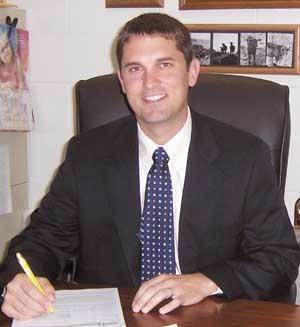
01 Matt Davis; New Eldon School Superintendent
Matt is the son of Judy's sister and brother-in-law, Janie (Steen) and Bob Davis.
I had known how exceptional an educator Matt was when he was the agriculture and
vocational teacher at my alma mater, Tuscumbia High School, several years ago. Matt was
also a good basketball coach leading the eighth grade boys basketball team to an extremely
successful season in 2004.
The problems modern educators face seem to me to be rather overwhelming compared to
years ago when one considers the societal differences, modern cultural problems, and the
involvement of state and national regulatory bodies. However, our first teachers faced
their own unique situations and problems at some very basic levels such as even just
getting to the school to begin with since no mode of transportation generally was present
other than "Shanksmare" (an old term used for travel by foot) or occasionally
horseback. The difficulties were especially significant for students and teachers at our
one room country schools which for many years were the only source the county had for
educating its students. Miller County had close to a hundred one room schools early on,
each of which had its own local board made up of a few local neighbors to the school. You
can read more about our one room schools at this location on our own website:
http://www.millercountymuseum.org/schools.html
We have had many exceptional teachers and educators in our Miller County school systems
and I would not begin to name them all for fear of leaving someone off the list. More
recent ones that do come to mind who were engaged for significant lengths of time at one
or more of our local schools were Lyle Hensley at Eldon and School of the Osage, Leland
Mills at School of the Osage, and Ray Doerhoff at St. Elizabeth. But when one goes back to
the beginning of the last century some very significant educators stand out as well, and
because of the length of time which has passed since then some of them may not be well
remembered. So I thought I would review what we know about some of our earliest Miller
County educators.
In Eldon, probably the most influential and capable early educator and administrator
was T.E. Vaughan (photo 02).
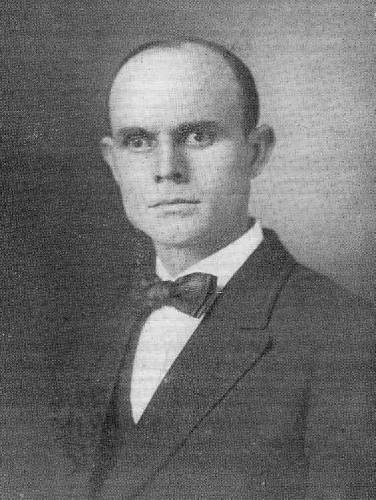
02 T. E. Vaughan
Superintendent Vaughan's tenure at Eldon beginning in 1907 is summarized on our
own website at this location:
http://www.millercountymuseum.org/schools/MCSS021.html#highschool
For convenience, I will copy here the segment of the narrative which describes this
remarkable man's achievements at Eldon:
"In the fall of 1907 T. E. Vaughan was employed
as superintendent of Eldon schools. In that year he completed plans for a graded system
that had been begun by a predecessor, and he also laid the foundation for the Eldon High
School. At the beginning of the school year 1907-8 the more advanced students were given
credit for one year of high school work on the basis of subjects previously pursued. The
enrollment of this class was twenty.
Superintendent Vaughan was the only instructor in the
high school that year. The total school enrollment for 1907-8 was approximately 400. In
the following year 1908-9, the enrollment in the high school had reached forty, and Miss
Grace Scott became Mr. Vaughan's assistant. The total enrollment in the public schools was
486. The growth of the town made it necessary by 1908 to add four rooms and the basement
auditorium to the school building. This building is now used for grades one to six. By
1909-10 the high school enrollment which had grown to fifty-seven made it necessary to add
a third teacher to the high school faculty. H. E. Keltner (photo 03) became
assistant in history in the high school and teacher of the eighth grade.
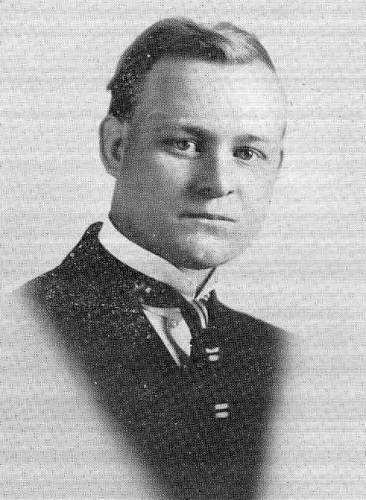
03 H. E. Keltner
There were also eight other teachers in the
grades and an average daily attendance in the entire school of 372. In the spring of 1910
Eldon High School graduated its first class, which consisted of Earl Collins, Griffith
Carpenter, and Prue Helfrich. In the same year the high school was classified as a high
school of the first-class. A letter written to H. D. Vowiel, Secretary of the Board of
Education, on October 17, 1910, by Howard D. Gass, State Superintendent of Schools, reads
in part as follows: "Dear Sir: Eldon High School has been inspected and classified as
a high school of the first-class with the following units approved: English, 4; Algebra,
1%; Geometry, 1%; Ancient History, 1; Mediaeval and Modern History, 1; English History, 1;
American History, 1; Latin, 4; Agriculture, 1; Physical Geography, 1; Reviews, 1; Total,
18. My inspector reports that your high school is in excellent condition and that it shows
evidence of substantial growth. I trust that you will be able to maintain the high
standard which has been reached in your high school."
From that time until the close of Mr. Vaughan's
superintendence in 1924, Eldon Schools maintained the same high standard of scholarship.
The next fourteen years saw a steady growth in enrollment of students and in number of
teachers added to the staff. They were also to witness changes in the physical equipment
of the schools and additions to the curriculum in both high school and grade school. In
1914 the district bought adjoining lots and enlarged the campus to 400 feet by 832 feet.
The present high school building was begun in the same year and completed in the spring of
1915 (photo 04).
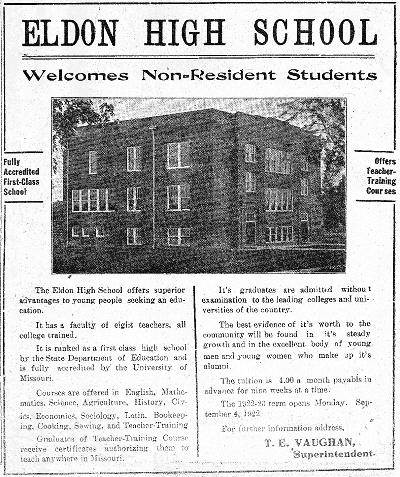
04 Eldon High School
Click image for larger view
It will always remain a monument to Mr.
Vaughan's excellent and faithful service to Eldon schools and community. By that year the
total enrollment in Eldon schools had reached 675. Of this number 144 students were in the
high school. The first class to be graduated from the new building in May, 1915, numbered
17. The number of teachers in the high school had increased to six and in the grades to
eleven.
In 1919-20 a change in the organization of the grades
was effected. Departmental work was introduced into grades seven and eight, and the
foundation for Eldon Junior High School was laid. Three teachers were employed for those
grades.
Additions to and changes in the curriculum of Eldon
High School are noteworthy and indicate the progressive policy of the administration. A
half-year's course in civil government was offered in 1911-12, and two years' work in
German and a year's work in domestic science were added the following year. The year
1913-14 saw the addition to the course of study of three teacher-training courses. A
year's course in biology and a year's course in bookkeeping were added in 1916-17, and in
that same year the courses in domestic Science were enlarged. A course in civics and
social problems replaced the old course in English history in 1918-19. The next two years
brought new offerings in the department of science when courses in physics and general
science were added to the curriculum. Within the next few years further additions were
made to the department of social science. In 1922-23 a semester's work in sociology was
offered to upperclassmen and in the following year a course in citizenship and vocations
and a half-year's work in American problems were added to the course of study.
During Mr. Vaughan's years of service from 1907-24
the total enrollment of Eldon schools had increased from approximately 400 to 810 and the
high school enrollment from 20 to 228. The number of high school graduates had increased
from three to thirty-eight. The number of high school teachers had grown from who was Mr.
Vaughn himself to eight; the number of grade teachers from nine to fourteen, four of whom
were teachers in the Eldon Junior High School."
Very few people are still alive who were students during the tenure of T.E. Vaughan as superintendent at Eldon. I have been unable to discover very much of his early history. I did find his name in a search of a list of late 19th century school teachers in Volume 2 of Clyde Lee Jenkins’ “History of Miller County” which indicates that T. E. Vaughan taught school at one of the early one room schools, Walnut Grove, near Bagnell in 1898 and also at Tuscumbia in 1899. However, one person is
still with us who had T.E. Vaughan as a teacher. She is Helen (Fendorf) Phillips (photo 05), who with her husband Louis,
originated and managed the Phillips Funeral Home of Eldon.

05 Helen Phillips
I talked to Helen recently, and she told me the following:
"Yes, I remember well Superintendent Vaughan.
You see, to begin with, he attended Westminster College in Fulton with my father, Fred
Fendorf. So as it happens, after my father passed away, my mother and I moved to Eldon. I
began the third grade in Eldon in 1918 toward the end of the school year after we arrived.
For some reason the regular teacher for the third grade was absent and Professor Vaughan
was substituting. He was a very stern man and demanded perfect discipline in his class. In
addition, he had a bad eye which was turned out so that when he looked at you his face was
turned a funny way; I suppose this helped him focus better. At any rate, maybe because he
knew me and my father, he wanted to give me attention. I don't know for sure. But anyway,
he looked at me and asked me first before any other student every question for the entire
day. I was frightened by his general demeanor and countenance to begin with, but when he
directed his questioning to me I became a complete mute! It was absolutely awful! And, of
course, being a new student at the school I knew absolutely no one in a school that was
much larger than the one we had at Tuscumbia. But no doubt exists that he was a very
competent teacher and administrator and I believe he was instrumental in the success of
the Eldon School system in its earliest years."
Thanks for the information, Helen.
While I was visiting Helen she gave me the opportunity to look at a couple of Eldon
High School albums, 1912 and 1913. These albums are so old that I doubt many people living
today have seen an edition of one of them. So I thought I would copy the photographs of
the students attending then for the interest of any of their descendents who may be
interested. T.E. Vaughan was the superintendent during these years. Here are the photos of
the 1912 annual (photos 06-19):

06 The 1912 Eldon High School Yearbook
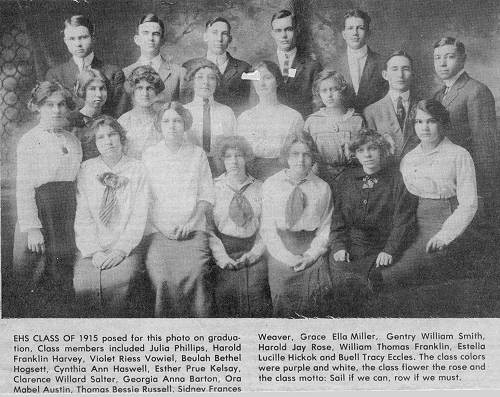
07 E. H. S. Class of 1915
Click image for larger view
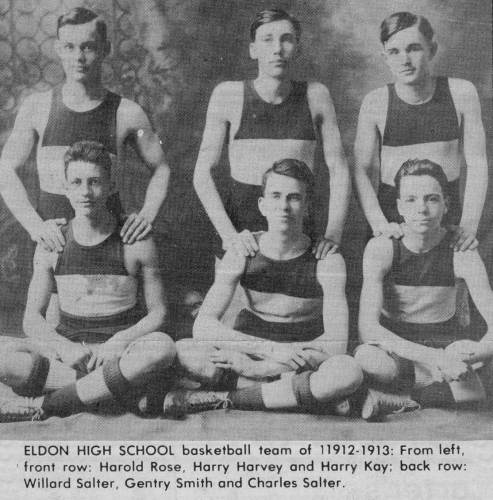
08 E. H. S. Basketball Team - 1912-1913
Click image for larger view

09 E. H. S. Graduates - 1914
Click image for larger view
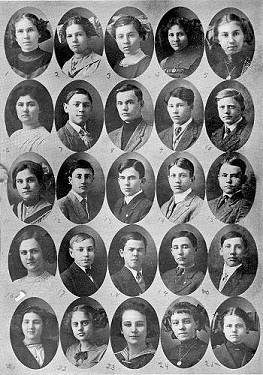
10 Freshman Photos
Click image for larger view
|

11 Freshman Photos with Names
Click image for larger view
|
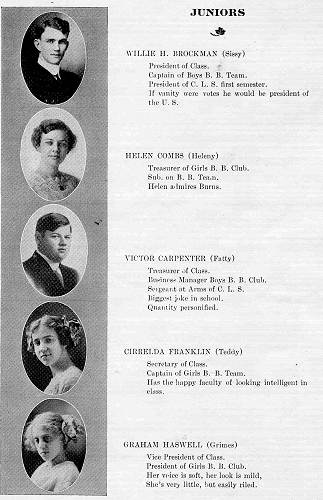
12 Junior Photos
Click image for larger view
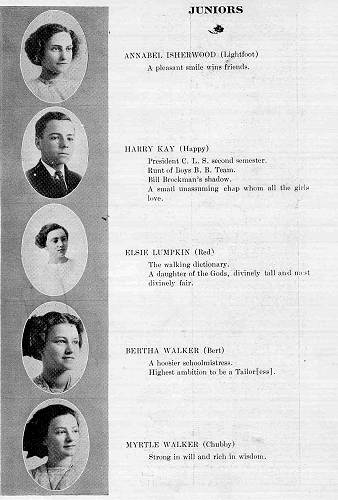
13 Junior Photos
Click image for larger view
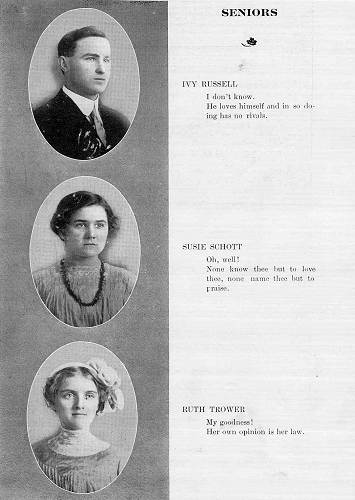
14 Senior Photos
Click image for larger view
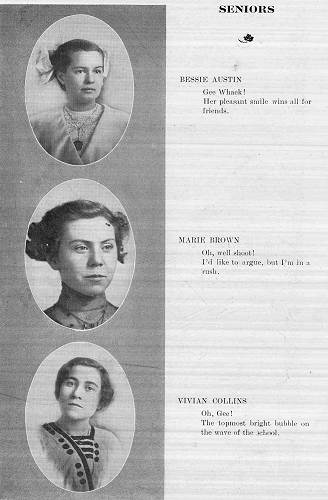
15 Senior Photos
Click image for larger view
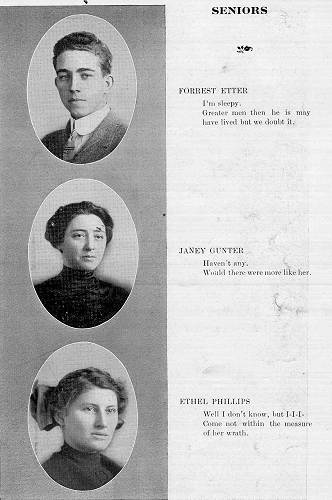
16 Senior Photos
Click image for larger view
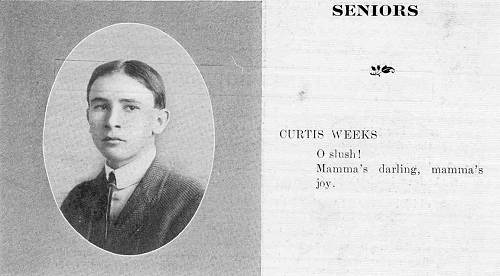
17 Senior Photos
Click image for larger view
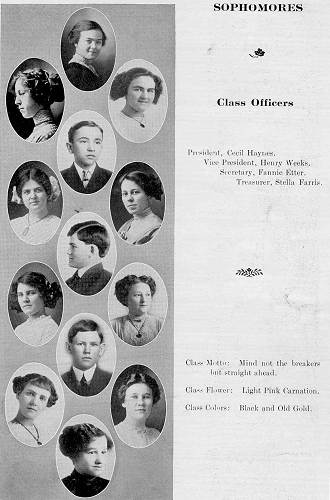
18 Sophomore Photos
Click image for larger view
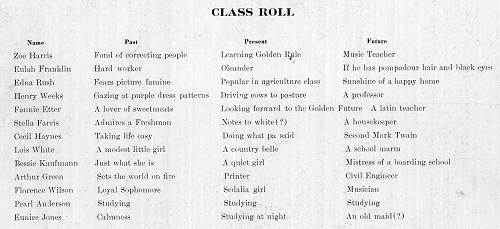
19 Sophomore Photos Names
Click image for larger view
Now here are the photos for the 1913 annual (photo 20-28). Unfortunately, the Sophomore photos didn't scan
well.

20 E. H. S. 1913 Yearbook
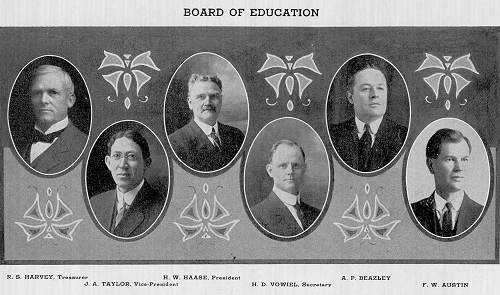
21 Board of Education
Click image for larger view

22 Faculty
Click image for larger view

23 Seniors
Click image for larger view
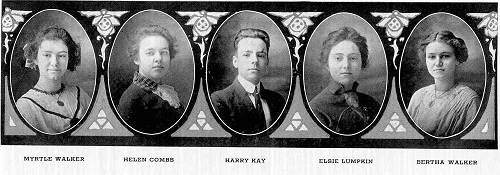
24 Seniors
Click image for larger view
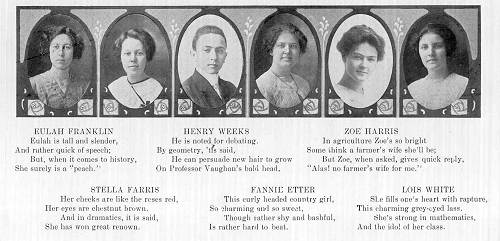
25 Juniors
Click image for larger view
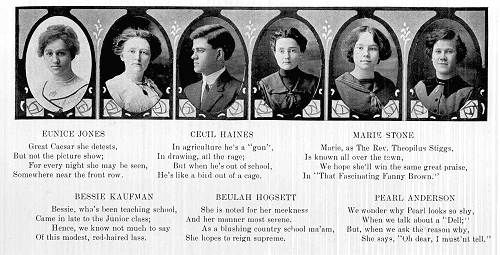
26 Juniors
Click image for larger view
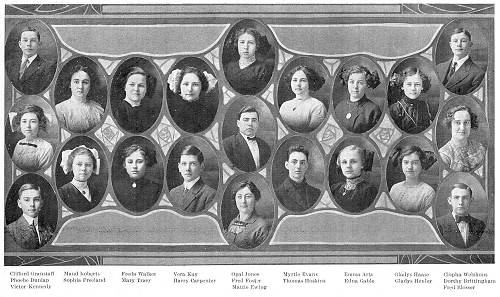
27 Freshmen
Click image for larger view
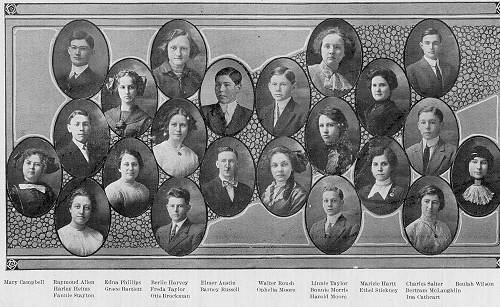
28 Freshmen
Click image for larger view
Moving on down to Tuscumbia, most people would say that Tennyson Clay Wright (photo 29) was one of the most influential
teachers in the school system there. Tennyson was a native of Tuscumbia whose father,
James Pinkney Wright, was a well known newspaper owner and author well known himself
throughout the county.
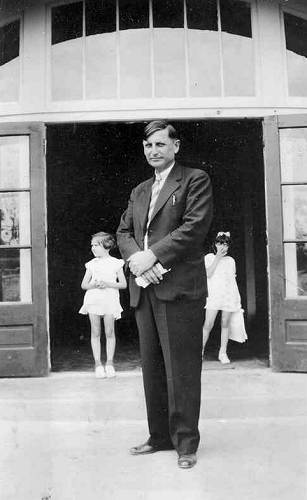
29 Tennyson Clay Wright
Tennyson was the grandson of James Lawrence Wright, the Wright family ancestor
who moved to Miller County in the early 1800's. T.C., as he affectionately was known,
exerted a very positive influential leadership style for hundreds of Tuscumbia students
many of whom attribute their success in life to his example and teaching over the forty
years he taught. He was born in 1889 and held his first teaching position at Bagnell at
the age of 16. Later, he attended Westminster College in Fulton and the University of
Missouri where he received his Bachelor of Science degree in 1923 specializing in
Vocational Agriculture. At Tuscumbia, he taught from 1920 until his death in 1949 at the
age of 59. He was well liked by the students because he could intermix with them in a
collegial manner yet maintaining their respect because they so well appreciated his
personal interest in their lives and futures. I have heard stories from many alumni about
T.C., more than any other educator I have known who taught at Tuscumbia or anywhere else
for that matter. It seemed to me important to get some of these stories and testimonies
recorded. For that reason, I am devoting several pages here to the memories of him by
several of his students. One of them, Maxine (Shackleford) McDonald, wrote a tribute to
him several years ago which I copy here:
While visiting up at school the other day, I noticed
the bronze plaque on the wall of the hall as you enter, there hanging among the pictures
of some of the boys and girls he helped put on the right foot of life. I doubt if any
graduate of Tuscumbia High School ever enters that school without some little memory of
T.C. Wright popping into his mind.
He was always busy, leading assemblies, working with
the F.F.A. boys, planning entertainment for the kids, scheduling ball games even softball
games for the boys in the summer months, just something to keep the kids' minds occupied.
Believe you me, we needed it. For entertainment there
was none here at home. He always stressed good sportsmanship above all things.
One Saturday afternoon a group of kids and myself
were impatiently waiting for T.C. to get back from one of his numerous errands. We were
supposed to get to go along with him to keep score for a softball game at Eugene. That was
our excuse just to get to go along as he only had a pickup truck then. He told us it
wouldn't be lady-like for us girls to ride in the back of the truck, but he'd squeeze in
three of us up front.
We waited and waited and no T.C. We knew he had to
eat his lunch and we just couldn't make it on time. He finally came, skipped his lunch
period and we were at Eugene, playing softball on scheduled time.
He had patience with the kids. He had a smile and
that familiar wave of the hand for old and young rich and poor. He once told a group of
girls that the best place to pick their husbands was in their own school. At that time we
sort of laughed, but looking back several did that very thing.
Mrs. T. C. Wright let me read some of the numerous
letters she has received from graduates, teachers and friends of T.C.'s. Each one seemed
to express the same thought. Each student wanted her to know how they felt about him, that
they did appreciate all the time he had given to them, helping them with maybe their first
big project or just a little advice. He was probably late for dinner many a time because
of us.
T.C. came up the hard way. He was one of five
children in his family. Mr. T.C. had a yearning to be a teacher. He gained most of his
education by correspondence and summer schools. During this time he worked his way leading
bands in towns such as Cisne, Ill., and was the song leader in revival services all over
the country.
He attended one year at Westminster College in Fulton
and received his Bachelor of Science degree from the University of Missouri in 1923. He
taught his first school at Bagnell at the age of 16 years. He rode horseback to and from
Bagnell each weekend. His earnings then were $20 per month and he paid $1 per week for his
room and board. During the summer months he was home from teaching and trying to earn a
little money. Also, as any young man this age, he was looking for a girl friend. He
attended a four day G.A.R. Encampment at Brumley which was a big affair in those days and
held by the Mill stream. At this encampment he was selling rubber return balls and
flirting with a cute little lady whom he'd never yet been introduced to. It seems he sold
the lady a return ball and inquired of an elderly lady who the young lady was. It so
happened this older woman was the young Miss' grandmother. The grandmother stated "If
you want to see more of her, just vote for her Dad this fall for county clerk and she'll
be moving to Tuscumbia."
W.S. Spearman was a successful candidate and the
Spearman family moved to 'Tuscumbia in 1906. Their daughter, Mary Paul, attended school
here and T.C. was her teacher.
In 1915 they were quietly married in her home by the
Rev. J.C. Thompson of near Ulman. Their favorite song was "Down by the Old Mill
Stream." He sang it to her while they were courting because they first met on the
banks of the Mill stream at Brumley. In later years this was the theme song of his band
concerts
He taught more than 40 years in the Tuscumbia schools
and at the time of his death was president of the Miller County Teacher's Association and
a member of the Miller County textbook committee. He continued his work until the fall of
1949 when he died of carcinoma of the bone. He exerted a marked influence for good on all
who knew him, especially on the hundreds of young men and women who knew him as a teacher.
One can't imagine the numerous letters Mrs. Wright
has received since his death and the clippings from so many papers and magazines on his
life. I'd like to share a few of these with you.
Asa Mayfield, El Reno Oklahoma, a former student:
"We believe that Mr. Wright was chosen by the Ruler of our Universe, to do a
particular job, that job was to mold the lives of the youth of Miller County. He did a
good job. His greatest joy came in helping others."
Mrs. Ruby (Moles) Brown, principal of the Eldon
elementary school: "We will cherish memories through our remaining years of an
outstanding leader, friend and counselor."
Joseph E. Kallenbach, Ann Arbor, Michigan, a former
pupil, now a professor in the Department of Political Science: "T.C. lived a rich
life, a life consecrated to serving others. He lived by the Christian ideals which he
believed in. He made his life a testimonial to the truth. 'He that would be greatest among
you let him be servant of all.'"
Velma Veasman, Dixon, former teacher: "T.C. will
be greatly missed. He rendered an invaluable service to mankind."
Mr. and Mrs. Ernest Howard, Kansas City, Kansas
(former pupils and father of Dr. Paul Howard of Tuscumbia): "He was a person we
admired very much, and the impression of his life we will carry with us through the
years."
Grace Kleykamp Mueller, St. Louis, a former home
economics teacher: "He was an inspiration to all who knew him, especially to young,
inexperienced teachers, like myself, who had nothing to recommend them except perhaps
their youth and their self-confidence. The young lives which he led and guided so
patiently and carefully to maturity are a fitting monument to his memory."
A.F. Rowden, Evanston, Illinois: "He was the
best friend a Miller County boy or man ever had."
S.A. Crouch, minister, El Campo Texas: "They say
that the front door of a home-the approach to a home-makes a bit difference in one's
introduction to that home. I was introduced to my ministry in Tuscumbia and Miller County
through the personality of a great soul, Brother T.C. Wright. That introduction and
approach made me a better man and a better minister, and added much to the success of my
whole ministry."
Lester Maddox, vocational agriculture instructor,
Mountain Grove, Missouri High School: "T.C. was loved by all of us. We shall greatly
miss him. Our annual conference will not be the same without him. With us he was an
institution, just as he was in his home community. He put life where it was needed and
added enthusiasm when morale was at low ebb. I have often envied him for his ability to
build character among his boys."
Riley Williams, Butler, Mo., former pupil: "This
you may be sure, the ideals he worked for and the principles he taught shall forever
remain a living monument in the hearts of all who loved him."
Helen Wells, Phoenix, Arizona, former pupil: "I
would like to say that he was a wonderful man and at the crossroads helped many of us. His
life was not a success only as an individual, but through so many young people he helped
make a success in life."
The editor of the Missouri Ruralist wrote in the
March issue, 1949: "The Missouri Ruralist editor feels a sense of personal loss in
the passing of Tennyson Wright. We know this fine man passed up numerous opportunities to
teach in larger school systems at higher salary because he loved his work and his
community. No money can compensate a man like T.C.Wright for what he accomplished.
"During World War II we were invited to speak at
the county grade school exercises and the Tuscumbia High School commencement. No music
instructor was to be had and T.C. Wright had volunteered to add the music department to
his work without compensation. He was doing a good job, too. This was typical of the man
who chose a small town and a strictly rural community in which to live his life and rear
his family. And the influence of T.C. Wright will be felt so long as his students, their
sons and boys of coming generations shall live."
The editor was a personal friend of Mr. Wright.
This was clipped from the February issue of a service
letter put out by the department of Agriculture and the State Department of Education:
"T. C. Wright made many friends during his 42 years as a teacher in Miller County as
was attested by the large crowd that attended his funeral. They went because they loved
the man, not out of curiosity as some go to the funerals of men who have been in high
places. For 30 minutes, on a cold and disagreeable day, his friends passed the bier
containing his mortal remains. Old and young, rich and poor, erudite, and unlearned people
went to pay their respects for the last time to a man they loved. It was a tribute far
greater than that received by some men who went to their graves after having received
great honors and having attained great wealth. Vocational Agriculture will miss T.C.
Wright."
Mr. Wright served as a member of the first committee
that established an FFA camp. He helped organize a night class consisting of boys and men
ranging in age from 18 to 24, married or unmarried, to meet in the agriculture room at the
school here each Monday night from 7 to 9 o'clock. Boys were returning from World War 11
and were unsettled as to what their occupation would be.
T.C. instructed the night classes, training them in
the most recent developments in farming. Many of them held part time jobs and some farmed
a little on the sideline to get the "knack" of things He was always on hand to
diagnose the ailment of their cow or pig and to offer a remedy or get a crew together to
help some fellow who had had a streak of bad luck.
He once remarked, "I've tried a little of
everything-hunting, fishing, etc. but I always failed," he said, "except at
working with my boys."
Mr. Wright only took one vacation and that was for
only one week. During this trip with his wife and son, T.C. Jr. he passed through the town
where Will Rogers Memorial is located. So at once he said, "We must stop here."
In entering the building everything is very quiet and the first thing you see when inside
is a large statue of Will Rogers. Underneath are these words, "I never saw a man I
didn't like." Mrs. Wright said, "I nudged him on the arm and said very quietly,
"Dad, that's just like you.'"
His love for everyone was behind the motive that
caused the folks of the Tuscumbia community to honor him by placing a bronze plaque in the
hall of the Tuscumbia High School. G. Berry, president of the Men's club, and Mrs. Denzle
Slone, president of the Women's School Welfare Club, made the presentation at the
commencement exercises.
In Memory of T.C. Wright
Born August 23, 1889 Died January
21, 1949
Taught in the Tuscumbia School
over forty years
His life was a life of service to this community.
G.A. Berry said at the presentation, "We believe
that his life was such that no monument of any kind is needed in order that the community
will remember him, but to show our deep appreciation for his life of service spent in our
midst, we, the Women's School Welfare Club and the Tuscumbia Men's Club, present to the
Tuscumbia Public School this bronze plaque in memory of our beloved friend, Tennyson C.
Wright."
On Easter Sunday 1949, Mrs. T.C. Wright and T.C.
Wright Jr. presented a picture of Christ to the Tuscumbia Christian Church in his memory.
The Reverend John Jenkins, who spoke at his funeral
best, expressed himself in the words of a beautiful poem, "A Real Man."
This is part of the letter written Mrs. T.C. form the
Tuscumbia Men's Club. "He brought to our community club an accumulation of wisdom,
gained through a long life time of efficient sincere services to his community, his
school, his church, his club, the county, state and nation. His high conception of the
basic aim of public education as an enlightening and safeguarding a true democracy was a
powerful force in helping his club, community, school, church, county and state,
throughout his exemplified life.
"Signed:
C.D. Snodgrass, President
Byron Hix, Vice President
E.A.Condra, Member
But to me the best words yet to describe him was the
definition of success by Bessie A. Stanley and included by Mrs. Doris Clemens in her
tribute to her uncle:
"He has achieved success who has lived well,
laughed often and loved much, who has gained the respect of intelligent men, the trust of
pure women and the love of little children; who has filled his niche and accomplished his
task; who has left the world better than he found it, whether an improved poppy, a perfect
poem or a rescued soul; who has never lacked appreciation of earth's beauty or failed to
express it, who has looked for the best in others and given them the best he had, whose
life was an inspiration, whose memory is a benediction."
As we are making plans for our first meeting in
establishing an Alumni at THS on December 17, we shall never forget the one man who has
done so much for Tuscumbia schools. Although he is not with us in body, he will be in the
hearts of those who knew and loved him.
Thanks Maxine.
Another commentary about T.C. Wright was given in a discussion between brothers David
and Arthur Bear (photo 30):
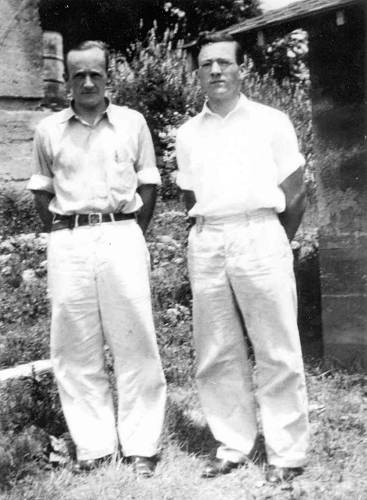
30 Arthur and David Bear
David: Arthur, let's talk
about some of the people in Tuscumbia who influenced you as you were growing up.
Arthur: Tennyson Clay Wright, known
as T. C., probably had the greatest influence on me outside of my parents. I attended the
last semester of the 8th grade in Tuscumbia, then on to high school where T. C. was the
superintendent. He had a long tenure as superintendent, and was there for many years after
I graduated. He was a gifted man. He taught vocational agriculture and also other classes
when needed. It was a small school with only three teachers. My first year there, I had
Joe Kallenbach, Stella Kallenbach, and T. C. Joe left the following year, and I can't
remember who replaced him, but T. C. was there a long time. About once or twice a week we
would have chapel, and he would usually read a favorite verse or verses of Scripture,
trying to teach us lessons in character. He encouraged us to learn how to
"think". One saying of his was, "Those who think will always govern those
who toil." I don't know who first said it, but he went over this time and again.
Chapel was scheduled for twenty minutes, but often it would last an hour. He didn't always
break it off for the next class. Sometimes we would miss a whole classroom period. T. C.
couldn't do that nowadays. Back then we had mostly Protestants in school, but there were a
few Catholics. Charlie Tellman and his brother had a few children there, but they didn't
seem to mind T. C.'s efforts. We all got along pretty good. Another man I admired very
much was Walter Stillwell, an attorney in town and owner of an abstract of title business.
He was a Presbyterian and superintendent of the Sunday School for many years. This was the
church where we attended. He was an Elder on the church board which was called the
session. He was a Christian man, very much reserved, but outspoken on issues that meant
something to him. Tuscumbia had a community band which T. C. probably organized, and Mr.
Stillwell was in the band, too. I played in the band a few years myself, probably five or
six years. T. C.'s brother, Lawrence Wright, was in the band, and Bob Stillwell played. We
had twenty-to-twenty-five in it. That was a good activity for those who participated in
it. Let's see. Well, I think T. C. and Walter Stillwell were the two main persons.
David: Arthur, I would like to say a
word or two about T. C. Besides my parents and grandfather, David C. Bear, I owe a debt of
gratitude to T. C. who did much to shape my basic beliefs and character. T. C. didn't know
that. I'm sure he had me dubbed a failure and he had good reason to suspect it. I was a
shy, but stubborn, child, poorly motivated to study in high school. Mom pushed me, but it
didn't help much. She wanted me in the glee club, and often pressured T. C. to get me in
it. One day he walked up to me on the playground and said "sing Doooooooo." I
purposely used a monotone voice in order to mislead him. He just shook his head and walked
off. He probably knew I was being recalcitrant. In chapel, he said frequently that if you
have nothing to do, just sit and think. Arthur referred to this already. Being an
unmotivated person, I did a lot of daydreaming about a lot of things. I would sit in study
hall, doing nothing but staring around thinking about a lot of things, including girls. T.
C. liked that. He referred more than once to me as a person who could sit and think. If he
only knew some of the things I was thinking! In spite of my rebellious behavior, I was
absorbing much of T. C.'s philosophy. I can still sing "do" in a monotone.
T. C. was one of the most versatile men I have ever
known. He taught vocational agriculture. He did most of the veterinary work around the
area, and it was all done gratis. People just expected him to help if there were a sick
animal around. Being a religious man, he preached funerals, organized choirs, conducted
the community band, taught music in high school, and helped in all helpful community
activities.
He was truly a man of many abilities, and he gave of
himself freely. He lived across the street from the high school where he also had several
acres of land. He always had agricultural projects going, and he used these to teach the
boys in his "ag" classes. From him I learned how to caponize chickens, castrate
hogs and sheep, and many things necessary to running a farm. Each boy in the class had to
have an agriculture project with careful records kept. One of the objects was to make some
money. He was way ahead of his time on ideas concerning farming.
I can recall back when I was young, the farmers each
spring would burn off their pasture land to get rid of the dried grass. They thought that
this was necessary to get good pasture growth in the summer. T. C. talked against this
practice because it often started erosion and it destroyed the humus. He was ridiculed
often for his beliefs. He believed in shallow plowing of corn. The farmers of the day
believed in deep plowing. The boys in the vocational agriculture class nearly always
reflected the views of their fathers, so many friendly arguments occurred in the
classroom. Time proved T. C. right on most of the things he advocated and did. He believed
strongly, as Arthur said, in character development. He thought that young people should go
on to higher education. Many people did go on to college because of his teaching. His
major goal, however, was for each person to be an honorable, upstanding citizen regardless
of his vocation.
Thanks Arthur and David.
Another testimony about T.C. Wright is remembered by Susie Bear Pryor (photo 31):
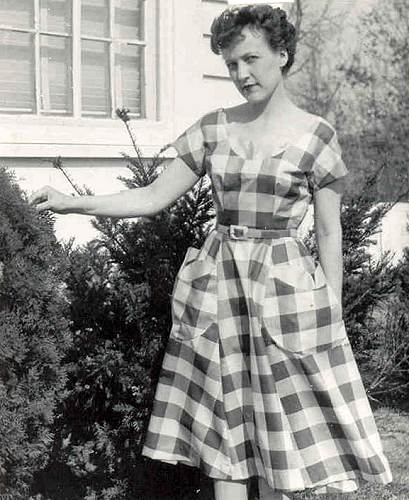
31 Susie Bear Pryor
"I will start out with my first
remembrance of Mr. Wright for I was in the 1st. Grade & didn't know that around town
& with older people he was called T.C. He must have sort of liked little kids for
since he was a Democrat & the majority of people in Tuscumbia were Republican he for
some reason liked to pick one of the 1st graders & sort of whisper the question in
their ear if they were a Democrat or Republican & of course they would tell him
something & it tickled him if he could get them to say they were a Democrat. And then
he would go & tell their parents what they said. Of course they were apt to say
anything for what did they know what they were?
I think probably he didn't pick up one of them &
ask that unless he knew their parents. I wasn't the only one he did that to for he had
asked others. For some reason he got a kick out of doing that.
I remember he would ever once in awhile come into
Gardie Swanson's room where the first three grades were & just stand there & look
around at us all & of course that tickled us. I remember thinking that was an honor
for him to come in. He was there throughout all my years until I graduated. As I grew
older I wasn't so shy around him. He was always on the go & in his shirt pocket he
carried a small black notebook in which he wrote everything down and which he consulted
many times a day. He was quite a leader here in town in many aspects. Every day when
school opened at 9:00 o'clock he held what we called an Assembly. All the high school kids
met in the gymnasium. First we would sing the school song & put our hands over our
heart. Then he would proceed with whatever issue was on his heart & it varied every
day but he was long on teaching us good morals & Christian themes. Sometimes he
couldn't get stopped & may have held assembly for an hour. He had no set time to
adjourn but just when he got through. One time during an assembly meeting Barbara Wright
was sitting in a little room that was our library for that was her job. He was talking
& she screamed out very loud. He ran over there to see what on earth the matter was.
Then he came back up front carrying a little mouse by the tail & holding it up for all
of us to see.
He was great on music & got up a glee club &
most of the high school kid's were in it. Of course he was our leader. Then one time the
School of the Osage was having something special where all the surrounding schools were
invited to go. Well of course he wanted very much to take all of us over there for it was
a competition thing. Then what happened was so embarrassing. There were several different
high schools that had entered it. I can't remember that anybody particularly dressed up
& I remember I just had on a sweater & skirt & not a new one at that. Well,
Monday, when we all got back to school & our assembly started he came through the door
& walked up to the front with his hands over his eyes trying to cover his shame. We
were the only school that had entered that musical contest that didn't have uniforms so we
would all look alike. Besides that our only music teacher had been Mr. Wright himself
& I don't know why if he was going to take us that he didn't know we should not go if
we couldn't be like the others. As far as I know Tuscumbia never attended another one of
those concerts. I remember before I went I was wishing I had something a little nicer to
wear for it wasn't even new.
But he never let that stop him from organizing more
bands. He got quite a few of the town's people together & formed a band & they all
had different instruments but of course they had to have bought them on their own
(photo 31a). I actually thought they did quite well.
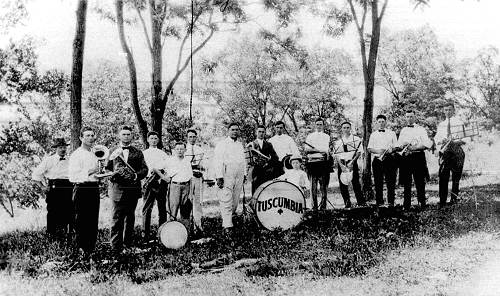
31a Tuscumbia Band - T.C. Wright, L.A. Wright, W.S. Stillwell, Robert or Roger Stillwell
Click image for larger view
They were all business men of the town. I don't
remember all of them that were in it but can name a few. Starting out first there were Mr.
Walter Stillwell & a couple of his sons, Roger & Bob. Also there were Lawrence
Wright & perhaps his oldest son, Gerald, Oliver Brockman, and my brother, Arthur, only
to name a few.
Arthur (Bear) had a great big base horn & it was
almost larger than he was. There was a fine band stand in our park that was built up high
in the air & underneath it was an ice cream stand. Up there the band really showed off
well & we could hear really good. That was something I remember that he had success
doing.
His services were called upon often for Tuscumbia was
a small town & we needed a community leader but not just anybody can render those
services. He seemed an outgoing person & did many things for the town. He was called
on to hold funerals for those who weren't connected to a church. That included many people
that needed that service. Maybe it would come up at the last minute & certainly not
planned far ahead & people all knew that Mr. Wright could do it & he would always
agree. He would start calling that morning to get singers to volunteer. He would play the
piano & lead the singers with them never having practiced together. He called me
several times in the morning to meet that same day at wherever he decided to hold the
service for you see he was the preacher too. He never turned anyone down & held many
of those services for those who needed him.
He was never idle. His house was right across the
street from the school & behind it was enough land that he had a pasture & had a
cow or two. He got up early & I don't know, maybe he had some school kid to help him
milk because he sold milk to all the stores in town & would deliver it every morning
before school started. I hated to walk up all those steps leading from down town up the
hill to get to school so I would try to time it so I could be right at the spot he would
be coming by after his milk route so he would pick me up & save me from those horrible
steps. Since he was the agriculture teacher there many of the farmers who would call on
him to come to their place & treat a sick cow. He was a veterinarian to those all
around. He certainly was a well respected man & all the kids that went to school in
Tuscumbia always have had fond memories of him. He was a great Leader in Tuscumbia.
Thanks Mom.
Another very important person involved in the education process for Miller County
children was C.D. Snodgrass of Tuscumbia. C.D. was county superintendent of schools for
many years and in that role had significant influence on the quality and development of
our country schools (photo 32).
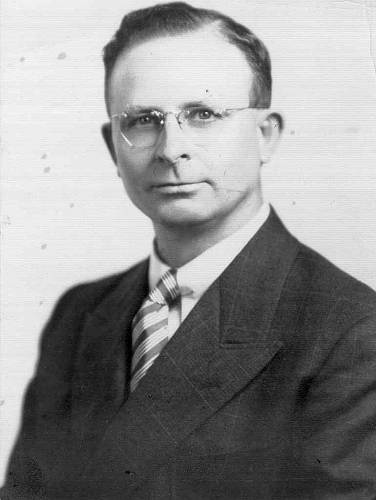
32 C. D. Snodgrass
Just about any teacher who was employed by the county during those years
appreciated greatly his influence and leadership not only for the teachers themselves but
for their students. C.D. was a very encouraging and inspirational leader for the students.
He made them feel good about themselves when they studied hard and passed their
examinations. In fact, he held an eighth grade graduation exercise every year at the
courthouse in Tuscumbia as a means of emphasizing to the students the value of what they
had accomplished by completing successfully the state requirements for graduation as well
as passing a rigorous test required for receipt of the certificate of graduation. The
following is a photograph of one of those graduation ceremonies. You can see C.D. standing
at the far right of the photo. A short narrative on the back of the photo gives some extra
details about the event (photo 33 and photo 34).

33 Eighth Grade Graduates - 1929 - Rural Schools
Click image for larger view
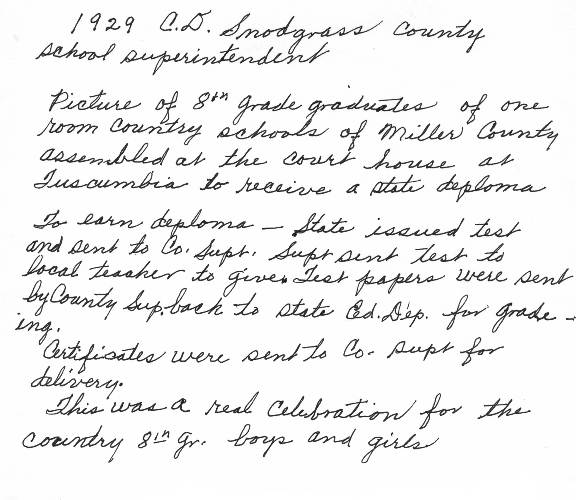
34 C. D. Snodgrass; Supt. Country Schools
I have been told by some of the teachers who were employed in the country school
system at the time he was superintendent that he was very attentive to their needs and
made regular visits to each school in the county. C.D. was county superintendent of
schools for Miller County from 1927 to 1950. After that time he practiced law until his
retirement maintaining an office and home across the street from the courthouse in
Tuscumbia. He had attended the state college at Warrensburg and later the University of
Missouri. He obtained his law degree before completing his education. C.D. also was a
candidate for State Superintendent of Schools in 1938 (photo 35).
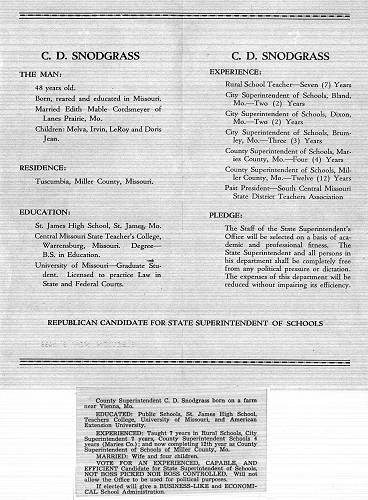
35 Campaign Flier
Click image for larger view
We have a couple of biographies on our own website about C.D. Snodgrass to which
you can refer for further information:
http://www.millercountymuseum.org/bios/bio_s.html
http://www.millercountymuseum.org/people/bio_s.html
One thing I remember about C.D. is that in his later years he had "Lou Gehrig's
Disease" which caused him to limp as it progressed. I still remember him gamely
climbing the outside steps to his office even though his legs were very weak. The disease,
known in the past as "Amyotrophic Lateral Sclerosis" and more recently as
"Motor Neuron Disease," usually is fatal and this is what the cause of his death
was.
C.D. Snodgrass's son, LeRoy, also was a well known attorney in Tuscumbia having been
elected to the office of Prosecuting Attorney for a number of years.
Traveling south of the river to Brumley another Miller County resident of the past
deserves to be remembered as an outstanding educator. The story of Cynthia Hawkins (photo 36) is one of the most inspiring one
can imagine regarding how the traits of perseverance and attitude can lead to success.

36 Cynthia Hawkins Spearman
Mrs. Hawkins was severely injured as a child when her hands and forearms were
crushed in a cane mill. Both of them had to be amputated at the elbow. But she completed
her schooling and began teaching at the age of 16. Further education led to more success.
In the Vindicator, a newspaper at Tuscumbia, it was reported that "Miss Hawkins is
one of our most successful teachers." (Vindicator, July 11, 1881). At the time
Cynthia was teaching at the one room school at Hickory Point. She continued teaching at
various schools in the county and as an example of the respect she had earned from the
parents of her students she was elected county school commissioner in 1895, the first
woman ever to hold public office in Miller County, and just think…at this time, women
weren't even allowed to vote!!
In 1937 at the Miller County Centennial celebration pageant Cynthia was selected for
the role of "Pioneer School Teacher."
You can read more about Cynthia at this location on our own website:
http://www.millercountymuseum.org/people/bio_s.html
(Scroll about half way down the page to find the article).
We have Cynthia's photo on our wall at the museum as a means of demonstrating our
respect for her accomplishments (photo 37).
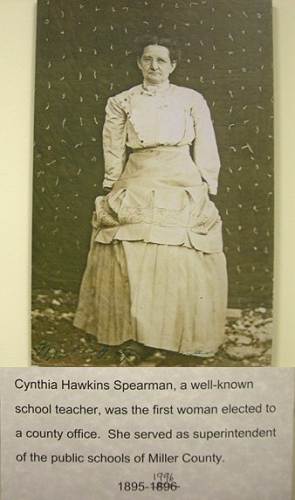
37 Cynthia Hawkins Spearman
Another teacher who suffered a physical impairment but minimized her disability through
determination and perseverance was Gardie Swanson of Tuscumbia. Gardie had polio early in
life such that her left leg was withered and weak. She had a noticeable limp when she
walked and had to use an ambulatory aid at times. However, she was one of the best early
grade teachers ever to teach at Tuscumbia. Almost every one of her students could read
well due to her teaching method which emphasized recognizing vowel sounds. She taught from
1919 to 1958. Many families in Tuscumbia have three and even four generations whose first
experience in school was the first grade under "Miss Gardie." My first exposure
to school was under Miss Gardie. So was she my mother's and her brother's and sisters'
first grade teacher. Here is a copy of her retirement ceremony from the Autogram in 1958 (photo 38).
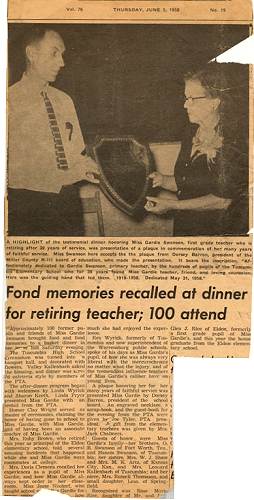
38 Gardie Swanson Retirement
Click image for larger view
In the south part of the county at Iberia probably most would agree that Professor G.
Byron Smith was the most influential educator of the area and most likely not only the
entire County but state as well (photo 39).

39 G. Byron Smith
He is the one who started the Iberia Academy and Junior College. Many of his
students went on to very successful careers throughout the state and the country. Almost
everyone who successfully completed the Junior College did well when they later attended
the University. The Academy was started in 1891 and was in operation for the next sixty
years until 1951 when Professor Smith retired. It is an amazing testament to his
leadership skills that the Academy closed its doors not long after that, even though
attempts were made to have it continue. The best narrative about the Academy and Junior
College was written by Peggy Hake and is on our own website:
http://www.millercountymuseum.org/schools/MCUN019.html
Be sure and read this article by Peggy, who is an Iberia native, as she has researched
the story of the Academy completely and also includes many interesting photographs of the
campus. I am including one photograph here which was taken at the last graduation ceremony
because it is of special interest to me. My Aunt Bonnie (Bear) Tyler is the young woman on
the right sitting with two of her class mates awaiting the graduation ceremonies later
that day (photo 40).
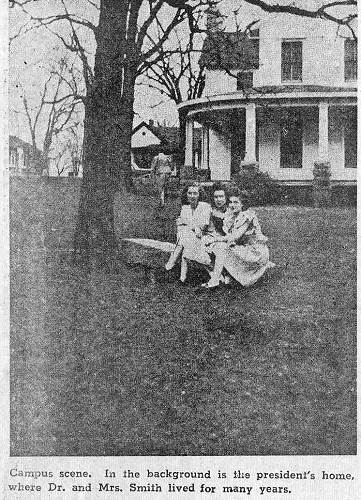
40 Juanita Morrow, Luella Condra and Bonnie Bear
Click image for larger view
One of the most energetic teachers during the first half of the last century in my
opinion was Maude Wright (photo 41).
Maude was born in 1896 near Spring Garden into somewhat deprived circumstances but due to
her constant and persistent efforts to continue her education after the 8th grade became
one of Miller County's most well known teachers.
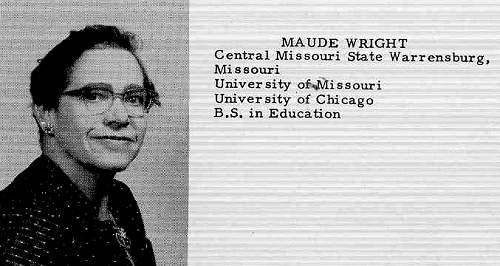
41 Photo from T.H.S. Album - 1956
She was the daughter of Joseph Lee Wright and a great granddaughter of James
Lawrence Wright, the first one of the Miller County Wright family to arrive here in the
middle 1800's. The Wright family originally came from Pennsylvania to Brazito, Missouri
around 1840. James Lawrence moved to the Little Saline Creek sometime later and that
location is where he built his well known carding mill.
As noted earlier, T.C. Wright, the very popular superintendent at Tuscumbia during the
first half of the last century, also was a descendent of James Lawrence Wright.
Maude taught for 48 years at many Miller County Schools especially having spent most of
her time teaching in the one room schools scattered around the county. She was my 7th
grade teacher at Tuscumbia in 1956. I include her as one of the exceptional Miller County
educators not only for her long career in teaching but also because she intuitively seemed
to know how to deal with school children no matter what might have been their personality
quirks or personal problems. She had worked hard to earn the necessary education credits
to become a teacher but she also had that something extra which endeared her to her
students. Many of the one room school teachers only taught for a few years and then went
on to other careers but Maude remained a teacher all her life, most of her career having
been spent in the one room schools. Before her death in 1999 at the age of 102, Maude
wrote a short autobiography which is interesting in that it portrays in some detail the
problems and experiences faced by these unique educators of the past who were the
"one room school teachers." The modern school and the contemporary student of
today have little in common with their rural antecedents of yesteryear.
My Story
By Maude Wright
Having taught school as a profession most of the
earlier years of my life, I decided to write about the schools I attended and where I
taught.
I was born on a farm of 60 acres purchased by my papa
for taxes against it at the courthouse. There was no town of Eugene then. Spring Garden
and Olean were our trade centers. There was a bank and mill at Olean that were in great
use.
This land extended to the Cole County line a short
distance from our house. The candidates of Cole County often came to our house when
campaigning, not knowing they were in Miller County. The house on this land was a long log
room with a large fireplace at the east end, and a "lean to" was at the south
for a kitchen. My pap built a bedroom to the west of this room later, and made other
changes.
On the eve of September 3, 1896, my mother told
father she was going to give birth to their first child. All children were born at the
homes then, as there were few doctors or hospitals. My father walked over three miles
through fields and woods to get my grandma, Ann Simpson, and an Aunt. When they got to the
home my father then rode 3 miles to Spring Garden for a doctor, Frank Devillies, who rode
back with him. The doctor soon after making a check announced the baby wouldn't be born
for a while and he went to bed. At 2:00 the next morning my grandma woke the doctor and I
arrived soon after and was named Dessia Maude Wright. I also had a sister born June 18,
1898 and a brother born April 23, 1905.
The school we had to attend was over three miles west
of our home. I didn't attend a whole term till I was seven years old. I attended three
months and then my father taught me at home. When my sister was 5 years and nine months
old we both attended school together.
This school land was given by Mr. Jim Dooley and it
was a cleared place on a rocky hill with woods all around it. It was called "Flint
Rock" School; also Hinds School as a number of Hinds children attended there. Where
the school yard was there were tall stumps where trees had been cut. Children liked to
stand on these. They were used as bases when playing ball, also. There were two strands of
barbed wire fastened to trees all around the school yard. The school house was built
facing the south. Large windows were located on both the east and west sides of the house.
A large box stove sat in the center of the house and a large painted black board extended
across the north end of the house. A long bench called the "recitation bench"
faced the black board, where all students sat while reciting. The teacher sat in a chair
between the black board and the recitation bench. Chalk was scarce. Some students had
pieces of "cotton rock," a soft kind of rock they used in place of chalk. Those
that could afford them had slates, some had double ones.
There were no built toilets at this school. The boys
were told to go to the woods north of the school and the girls south for toilet needs. The
lunch pails were placed on a shelf like place near the door at the south west corner of
the room. All seats were for two persons, with a place for the books. Also, the top could
be let down. A great draw back to this school was the lack of a well. A cistern was dug a
short distance from the house and during vacation the rain water was caught on the house
roof which then ran into the cistern through a trough made of lumber. There were three
school board members and their one task was to see that the cistern was cleaned when
school closed. There was a pump on the cistern. Also, we occasionally took a large bucket
to a spring on the Sullens farm. By the time they got back a lot of the water had splashed
out and not all students got a dipper of water. Everyone would want a drink, whether they
were thirsty or not. The three board members were usually the same ones from year to year.
I remember Mr. Jim Dooley, Jimmie Miller, and Will Sullens when I attended. The term of
school was 6 months long and sometimes there were 3 months of the term in the fall then
three months in the spring skipping the winter months December, January and February.
Occasionally a teacher would plan a program and
invite the parents on Friday afternoon. Sometimes there would be sides chosen for spelling
and ciphering matches. The winning person of a side was honored with a prize of candy or a
toy. Sometimes one student would say a poem and one of the parents would give a talk. A
few times a basket dinner was held the last day of school. Here the parents visited and
expressed opinions about the school.
We were at the extreme edge of the district and had
to go three and a half miles to school. We went only a short distance on the public road,
and then we went through the woods on a road over land where the owners hauled wood or
went to the fields with to plow or cut hay. We two were joined by several other children
where the public road and this road junctioned. The Simpsons, Henleys, Jenkins, and
Sullens children joined us. In all there were as many as 15 pupils in this group. There
were some students eighteen years old.
Our lunches were not prepared foods. We had biscuit
and meat sandwiches with boiled egg and pickles. Some bought molasses and butter and
bottles of milk. Most all had some kind of fruit such as apples, plums, or grapes. All
these were plentiful on most farms. My first teacher was Miss Anna Shubert from south of
the river. She boarded at one of the patron's homes. She was very strict as to discipline
but gave time to all alike. She had some students almost as old as she but they were
studious. The average attendance when I started was 52 pupils. This number continued until
the early 1900's when the Rock Island railroad was built. The people working on the
railroad lived in tents near their place of work as there were some large cuts and fills
and two bridges to be built. Our school was crowded with the children of these workers.
There were so many extras at "Flint Rock" that the younger students had to sit
on sawed off trunks of trees around the sides of the room. The completion of the railroad
had a great effect on the lives of the people in our area. The town of Eugene came into
being when a Mr. Ritchie built a flour mill there. Farmers began to raise more farm
animals. A cattle pen at Eugene was seldom empty as some one always had cattle or hogs to
ship to large markets. St. Louis seemed to be the best market in the early 1900's.
Most of my teachers after Miss Schubert were women
teachers: Ellie Miller, Nancy Simpson, Ada Simpson, Sylvia Lumpkin, and Gertie Brockman
were some of my teachers. Mr. Tilden Lumkin was my only man teacher. He was very strict
but well liked. Most teachers would teach more than one term. With the completion of the
railroad our school began to deteriorate.
The County Superintendent of Schools began to talk
consolidating the schools. This meant dividing some schools and sending the students to
the next nearest school. "Flint Rock" was divided. The students in the north
part of the district were sent to Spring Garden; those on the south to Gageville; those on
the east to Eugene and those on the west to Etterville. I was in the eighth grade when
this happened. Now I had to go only an eighth of a mile to a school located in Cole
County. However, in Cole County we had to be voted into the Eugene district at the April
election before we could attend so my father had to pay tuition for me until this
happened. The Eugene students had already taken the required 8th grade examinations so
Cobe Miller and I went to Etterville and took this examination with the students there to
be admitted that coming term at Eugene as high school students.
I was anxious to go to the Eugene High School; it was
much nearer. However, one very sad memory of attending there was when my sister, Lucile,
was killed by lightning coming home from school, November 21, 1908. Mr. O.O. McMillian was
the superintendent at Eugene the following term when I attended.
So much for where I went to school; now I'll write of
where I taught. I will tell some interesting events I remember while at each school and
name a few students.
Near the close of the school year of 1913-14 I went
to Jefferson City and took the teachers' examinations in March and received a second grade
teaching certificate. Before this I had read the required pedagogy books and thought about
teaching as a career.
One day Miss Dorsie Scott Etter, who was the lower
grades' teacher had a dental appointment at Eldon on a Friday afternoon. These grades were
on the lower floor. She went upstairs and asked that some students be sent to take over
her room as teacher from 1: 30 to 4:00. She wanted to go to Eldon by train at 1:30 and
return on the local at 5:30. Mr. McMillian, the superintendent sent me. I was glad to go.
I had just taught two classes when three school board members came to visit. They were
Jonathan Roberts, John Bill Rush, and Tolbert Binkley. All had children in this room. I
was nervous but went ahead and the longer I tried the easier it became. At 4:00 p.m. the
men visited a while with me and Mr. McMillian. Early Monday morning Mr. John Bill Rush
came to our home and asked me to make an application for a teaching job for the next year
as the board was meeting that night. I thought it over and after school that day I filled
out an application and took it to Mr. Binkley who lived only three houses away. I was
informed in a few days I had a job for the year beginning September 7 to April 23, 1915. I
had one pupil almost as old as I was, Vasca Thompson. I had several cousins and my brother
Nile was in this room. I had trouble with several beginners knowing the letters
"B" from "D" in words. I made some cards with the drawing of a
"Bee" and the letters on each. If after several days they still didn't know
these letters they wore the card with a string attached which they put around their necks
for a day. If they still didn't know they were told a spanking was to come later. I
spanked three of these 21 finally and one was a cousin of mine, Prue Wright Sanning. Her
mother called that night asking how I was for she said Prue reported my arm was blue when
I got to her. I had a register for several years to show how crowded this room was.
I took courses by mail and attended night classes
till I had credits for completion of high school. I attended school at Warrensburg each
summer. The next year I left Cole County and went to Mt. Pleasant in Miller County. Here I
had all grades, but few in each grade. Mary Wetzel Jones came, who was only 5 years old,
but cried when her brother and sister were gone.
I was told not to give much time to those who were
not regular students. I boarded across the street from the school with the George and Rena
Miller family. Jessie Miller, their daughter, married Allie Bacon November 7, 1915. Two
other weddings were held that same evening on nearby farms. Armond Haynes married Myrtle
Brown and a Madole boy was getting married. Different groups were going to charivari at
all three. Some were at one place and another group at another place so each had three
charivaries. I next taught school at Spring Garden. Here I had students I had gone to
school with at Flint Rock. Raymond and Mildred Sullen were two of these. The school room
here once was part of The Miller County Institute. There was an upper floor but the steps
leading there were behind a locked door. The room was large but more comfortable than at
Flint Rock. The stove was in the middle of the room. It was here, I think, hot meals for
students started. Students and I who wanted a change, brought bottles or cans of soup of
various kinds. I had a large kettle I put all the soups in and at the noon hour would put
a dipper of their soup into a dish they had brought. This they ate with their sandwiches
and dessert. The parents seemed to like this idea and would gladly furnish good food. My
second year here was started in the fall in early August.
As I would get out early the next year, the County
Superintendent of Schools and the three board members of the Harmony School came after me
to finish a term there as the teacher there was released for many reasons, one being her
inability to control the older boys. After thinking about this, I consented and went. I
boarded at the home of a Mr. Walter Craig, not too far from the school house. The older
boys, who had caused so much trouble, became obedient to my commands and were my good
friends. Afterwards, I was asked to stay for the following term, but was under contract to
go back to Spring Garden.
I remember a small store at Spring Garden was located
nearby. It was hard to keep the children from crossing the road and going to the store for
gum or candy or maybe a pencil as an excuse at recess. I was at Spring Garden 4 years in
all. While there Ruth Hill who had been exposed to the smallpox came to visit and entered
school there. Her brother lived nearby. She took the smallpox and the entire school became
victims. This disease swept through entire families. I and Edith Henley Groose, a
beginner, were the last to have the disease. I went to Eldon when I was able to see Dr.
Allee to find out if it really was smallpox and it proved to be.
I next taught at an adjoining school called the
"Bond" or "Klindt" school. I had bought an old Model T Ford car and it
was a snowy winter and at times I had trouble getting there on time. I enjoyed the year
there with children of the Miller, Gaither, Klindt and other families.
In between some of these terms I went back to Cole
County at Eugene. I taught at Harbison while living in Eldon and drove a car daily to
school. One cold snowy morning I got to the long hill south of Eldon on the old road and
the car slid to the edge of the road. I got out and walked to the Little Buck Horn Café
at the top of the hill I had come down. I called Tomkins Chevrolet Garage for help. As I
was going to make the call I noticed two other cars behind me on the hill were in the
ditch also. These people asked me to call certain persons and deliver certain messages.
Tompkins' couldn't come for a while. As I walked back the road grader had come while I was
putting in the calls and the others in the ditch were gone. I finally got to the school at
10:15. A note was written on the blackboard by Mrs. Nellie Jones, the mother of Jane and
Bobby Jones saying she kept the students until 10:00 and dismissed them.
I finished college at Warrensburg in June 1925 with a
B.S. in Education and taught high school 4 years at Barnett, Missouri. The Superintendent
was Robert Jordan for 2 years and Gentry Lowe was Superintendent the last 2 years there. I
and Mr. Lowe went to the Olean School in 1930-31. I boarded with Mannie Broox and Mr. Bill
Renkin. One morning my plate at the breakfast table was turned upside down. When I turned
it over there was a card with the Baptist Creed on it. A Mr. Prat Amos had given it to
Broox and said tell me I was a Baptist and didn't know it. I stayed there three years.
I taught at Gageville when the building located there
now was just finished. The board members painted the door and window facings on Saturday
before school was to start on Monday; a sign "fresh paint" was at the side of
the door. Every child that was barefoot (and most of them were) seemed to doubt the sign
and had to test the paint by stepping on instead of over the threshold. By the time school
closed on Monday the board at the bottom of the door opening was covered with black dirt
and I'm sure many little toes that night required special washing. This house was made of
cement blocks made by a Mr. Wilds.
I was principal at the Tuscumbia High School the year
Mr. Churchill gave his famous address at Fulton, Missouri. Miss Eska Helsel Fendorf was
the Superintendent. All superintendents got free tickets to Fulton to hear the address.
Eska went leaving me in charge. She gave us all a report of the address later.
I became a candidate for County Superintendent of
Schools in 1935 upon the urging of friends. There were two men opponents and one had been
my Superintendent at Barnett. I was asked to drop out and throw my influence to one of
these, but I refused. I was badly defeated partly due to stories started about another
Wright girl reported to be me. I went back to Morgan County for a while and then later
taught 7th grade at Tuscumbia. I retired in 1960 after teaching again in Barnett the lower
grades. Some of the students I had who became teachers were: Otto Jobe, Tirzah Spalding,
Mildred Graham, Flora Groose Queen, Ester Binkley, James Dawson, Edna Stevens, Glenn
Thomas, Myron Taylor, and Lena Spalding.
Some of the best students I recall were: Clyde Lee
Jenkins, Herman Schulte, Hazel Kallenbach, Johnnie Setser, Joe Riffle, Clara Burks, Warren
Kallenbach and Willard Schulte. In fact, I had no student I didn't like but I had some
about whom I didn't like some of the things they did. The fussing of the children came
with consolidation of the schools which changed teaching greatly.
I attended Chicago University one summer and started
work on my master's degree, but didn't finish all the required work. That fall I started
with a primary room and very fortuitously that year went to Superintendent of the school
from December to May. How it happened was that Mr. Crooks, the Superintendent at Eugene
was from Putman County and ran for representative there and was elected. Since I was the
principle he told the board I could finish that year as he wanted to be released in
December. I sent in my resignation since I thought this was too much work. The board
wouldn't accept this and promised me extra help.
Now for the materials used during the above mentioned
days and who was responsible for some of these changes made. There were no hot meals,
parent teacher meetings, athletic tournaments, libraries, course of studies, aptitude
tests and teachers' meetings. Certain State Superintendents of Schools and also the County
Superintendent of Schools had a lot to do with the changes that came. W.P. Evans was state
Superintendent of Schools in 1913. He worked for the consolidation of schools. Many small
schools were done away with but larger schools were the result. Charles A. Lee was State
Superintendent o schools in the early 20's. He worked for the improvement of all schools
and especially the training of teachers. Libraries and courses of study were introduced
during this time. The two county Superintendent of Schools that were in office when I
taught were John Lumpkins of Cole County, James Messersmith and Charles Snodgrass of
Miller County.
Every student had his own book. The books were passed
from one person in the family to the next. The first book a student had was called a
primer. It had simple stories with pictures to illustrate the stories. These were all in
black and white, no colors. Many of the lessons were about animals such as "The Hare
and the Tortoise," and the "Lion and the Mouse." There were some religious
stories also. The first readers I remember were the "Health Readers," followed
by"The Chores Readers." There was no uniformity until the consolidation of
schools came; then a course of study was made available telling what and when such
subjects were to be taught. Most early books and materials were kept at the drug store.
There were never many on hand. During the Christmas Holidays there were many little
booklets and picture books easy to obtain here. They were in colors that were appealing.
They had the letters of the alphabet with the picture of something beginning with a
certain letter like "A" for apple. Many children learned their letters this way.
At home nursery rhymes were a great part of these booklets.
With the coming of the "State Course of
Study" the libraries became a need. It was thought more knowledge of writers and
their works were needed so a book called "Literature and Life" was to be taught
in the High School. This included works of all great writers from all countries like
Shakespeare, Tennyson, Browning, Longfellow, Whittier, and Mark Levain. The libraries
became enlarged as many more writers' works were in demand. Harold Bell Wright, Zane Gray
and Mark Twain wrote a series of books which were used. Book reports were required in high
school English classes.
Our slates were used in Arithmetic, Spelling, and
Reading classes. The teacher put small problems on the board and the students copied them
on the slates with the answer. We learned to count to 10 by their fingers and perform
subtraction. After slates came jumbo tablets. Every inch of the tablet was used. The
little ones up to the third grade used only slates.
My first spelling book was called "Progressive
Speller." It had two rows of 6 words each printed in semi-large letters and then
these words were written. Sometimes a few lines would be written using the words in rows.
As we progressed more books were added.
A world globe and large maps were a part of the
library needs in the early 30's. All students took their books home with them at night in
a book satchel made of blue denim. It had a strap that went around the neck. The parents
would help the children at home if they could. It seemed the students then seemed eager to
learn. Copy books came into being in the early 30's. These were helpful to the young
student. The capital letters and small letters were used in various sentences showing that
all sentences should begin with capital letters as well as the name of important places
and people etc. Children were told to copy from these books on to their slates of paper
and take to the teacher and parents for inspection.
The first library in any school I taught was at
Eugene. There was a large box nailed in one corner of the room. It had a top which opened
into the room and also made a case for the books. Into this box books were donated by
families of the district whose children no longer read them. They were very simple
like" Little Black Sambo," "Cinderella," "The House that Jack
Built" and 'The Seven Dwarfs." Those who had no books liked to read these. They
were checked out at intermission and placed on the teacher's desk when school closed
daily. Soon all schools had libraries and the district bought the books.
Now as to discipline. No student talked back to his
teacher or refused to obey. No student used vulgar language or tried to hurt another
student. No fighting was allowed but it would happen occasionally. Whippings were allowed
by the teacher then. Detention after school and standing in the corner of the room
sometimes with a fool's cap on were used. Many parents would also punish their children if
they were punished at school. There were few drop outs or expelled pupils unless they were
above the real school age and disturbing.
Games in the early days were played with great
determination; Anthony Over, Blackman, Stealing Sticks, and many kinds of ball games were
played. The balls were made of cloth sewn together and wrapped with the unraveled tops of
the cloth sewn together and then wrapped with the unraveled tops of the worn out socks of
the family. Then they were carefully sewn with carpet wrap. They were cared for by the
owners. Whistles were made from the hickory limbs in early spring. Swings were made from
hickory bark also.
Most teachers had switches on hand and paddles to use
if needed at any time. Spanking and shakings with the hands were used, often more so on
the younger disobedient students.
Amusing things happened daily. I will tell of some of
the unusual things that happened in my school teaching at Barnett. There were two students
who were extremely romantic; the boy was custodian of the building. The superintendent one
day asked me to go talk to this boy who was in the coal shed getting fuel. She said he
would listen to me, but disliked her discipline. I went and began to ask him how he
thought the actions he and his girlfriend had been doing looked to others, like holding
hands, hugging etc. He listened and then said almost crying, "you don't know how I
love Beauly." I turned and said no more; I guess he did love her for they married
later.
One day when teaching American Problems we were
studying means of transportation. We had discussed Indian trails and river boats, and were
to study railroads the next day The Rock Island Railroad tracks were being laid at the
east side of the town of Henley. An engine with a flat car loaded with ties and railings
would go over the tracks already placed and leave what would be used next. A Mr. Looten
came to town in a one horse buggy this day. He had never seen a train and fearing his
horse would be frightened he unhitched his horse and left the buggy and horse behind the
blacksmith shop. He got a hair cut, bought his groceries and some socks at the store, and
visited with friends around town. By the time to go home the railroad tracks had been
placed through the small town of Henley. He got between the shafts of the buggy to pull it
up to the horse when the engine blew a whistle and Mr. Looten ran away with the buggy
breaking the shafts. He now had to have the blacksmith help him repair things so he could
go home. A number of students vouched for this being true.
Another time in an English class we were to study,
"Elegy Written in a Church Yard" by Gray. In preparation I gave some words to
look up the meaning like eulogy elegy, epitaph, etc. The next day I began to ask the
meanings of these words. One student kept wiggling his hands wanting to answer so I called
on him to recite. Several had told of epitaphs they had read on tombstones so this student
did the same. He told the cemetery name and the place this epitaph would be
found:"Here Lies a Mother of 28; there might have been more but now it's too
late." Of course, all the rest roared laughing, but another student volunteered the
same facts, and challenged all to go see for themselves.
Every school has its student of students who is
mischievous and sometimes really bad. At Olean I had a student who was part of every
disturbing happening. However, he never told me a lie. If asked if he were guilty, he
would reply"yes". Now the room assigned me at Olean had the best up to date
teacher's desk of any place I taught. Beside the desk was a waste basket made of reeds
woven in rows not too close together, leaving a little space between the rows. This
container was about 18 inches high. One day I found the papers in it because it had not
been emptied. I concluded the janitor forgot it. Soon after school began this paper basket
began to move. It would go maybe 4 inches then stop for a while, then go again. Soon all
the children were conscious of it moving and were looking. This one boy wanted me so badly
to go see what was the cause but I appeared unconcerned. At recess when all were out of
the room I went to investigate and placed the basket by the desk. At the bottom of the
basket was a large terrapin. It was really beautiful. He could put his leg through the
space between the rows of reeds and his claws would touch the floor so the basket moved. I
put the terrapin in the desk until noon. This boy asked if I found out why the basket had
moved after all the students had returned and I knew he was the culprit. Later I freed the
terrapin after school although in way I hated to see it crawl away; it was so beautiful!
The most disturbed I ever was while teaching involved
a little 7 year old girl. 'Dotty Kallenbach's home was only 4 houses from the school yard.
At the last recess she failed to be in the school when classes resumed. Her teacher
searched as all the rest of us did when notified. Finally, I said let's go to the home.
Her teacher and brother went to the home and found her in bed. When questioned she said,
"I got sleepy." Her mother was at the grocery store and was as surprised as the
teacher when she returned.
Students can be impressive, some more than others.
There was a certain student at Eugene who I had to punish so often I felt badly . He left
the year following graduation for the navy. I got a letter thanking me for what I did for
him. I often said to a lazy student, "You will never amount to anything if you won't
work." One student I said this to often said to himself, "I'll show her,"
and became a great business man. To some this sentence meant nothing. I hope what I said
and did were helpful to all. It was hard not to be partial to those who obeyed and tried
to learn. At heart there are few really bad students. If I hurt any student in anyway I
ask forgiveness and wish them well.
I taught at all these schools in Miller County:
Spring Garden, Bond or Klint School, Mt. Pleasant, Harbison, Harmony, Gageville, and 3
times at Tuscumbia. I taught at Barnett in Morgan county three times and at Eugene in
'Cole County three times. I never applied for a school but twice. I am grateful to these
districts for hiring me and hope I was worthy of my labor. '
I began with a salary of $30 a month at Eugene and
did my own janitor's work. I finished at Barnett with a salary of $140. This amount was
huge to me.
I had these as Superintendent where I taught: O.O.
McMillian, Robert Lee Jordan, Tennyson Wright, Gentry Lowe, and Forest Crooks. Some were
more cooperative than others. Some when they saw a mistake I made, would call me into
their office for discussion of the problem; these I was partial to as I had trust in them.
The following teachers I can't forget as they helped
me share problems with them: Nettie Clemens, a home economics teacher, and Miss Marjorie
Roberts, a math teacher at Eugene, were a great inspiration to me. Jessie Nixdorf and
Frank Newell Wright at Tuscumbia helped me in many ways. Binford White at Barnett was
never too busy to listen to my problems.
Elisha Taylor, Emma Dunstan, John Bill Rush, Emil
Shell, Val Kallenback, and Dwight Jenkins were board members I greatly respected. They
didn't hesitate to tell me about mistakes and how to overcome them. There are many
students and parents who I can't forget who I haven't named but are still in my memory. I
pray that Miller, Cole, and Morgan County are all better for my being there.
God bless you all.
Maude Wright
Thanks Maude. One more thing about Maude. She was raised in the north part of Miller
County around Spring Garden where a number of black families lived at the time. We have on
our website a series of articles about some of the Miller County black families who stayed
here to live after the Civil War. One of these articles was written by Maude Wright and is
very interesting. You can read it at this location on our website:
http://www.millercountymuseum.org/bios/bio_black.html
You will need to scroll a short distance down the page to read Maude's article.
You can read more about the schools where Maude taught at this location on our website:
http://www.millercountymuseum.org/schools.html
After reading this introductory page about the general history of the one room schools,
click on the heading at the top of the page which gets you to this site:
http://www.millercountymuseum.org/schools/orsp.html
On this site is where each one room school is listed which, after clicking on the
school name, you will bring up a page with that school's history. Many of these narratives
also include photos of the schools and occasionally class photos as well.
One of the interesting things we feature at the museum is a guided tour of the old
Lupardus Cabin given by Sharon Steen Holder. Sharon's grandparents, Willard and Maggie
Boyd (parents of Sharon's mother, Elva Boyd Steen), lived in the old cabin for quite a few
years and their grandson, Gary Flaugher, still owns the farm. Gary was the one who donated
the cabin to the museum. You can schedule your group for a personal tour of the cabin
given by Sharon by calling her number: 573 392 6002. Below are a couple of recent photos
of Sharon giving her lecture/tours (photo 42
and photo 43).
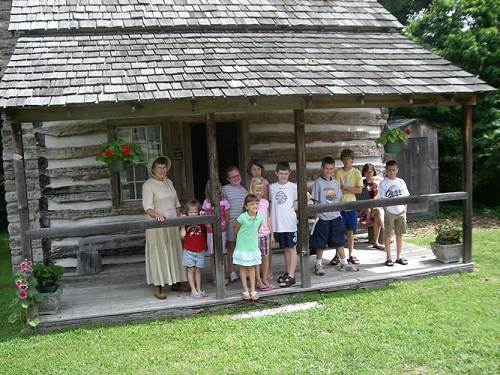
42 Sharon Holder with Class of 9th St. Christian Church
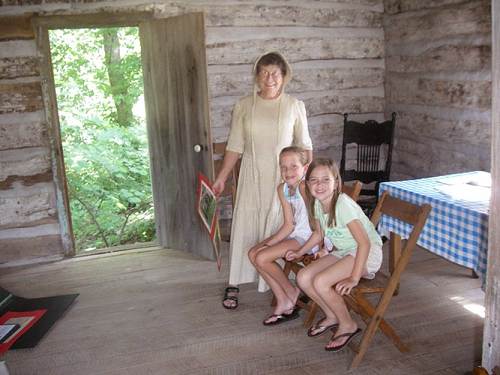
43 Sharon Holder with Lizzie and Hanna
Coincidental to the above, we recently received as a donation an old framed photo graph
of Willard Boyd, Sharon's grandfather, when he was only two years old. Also donated was
the actual baby garment Willard was wearing in the photo. Another photo accompanying these
pictures features Willard as a baby sitting together with his parents, John and Zell Boyd (photo 44, photo 45 and photo
46).
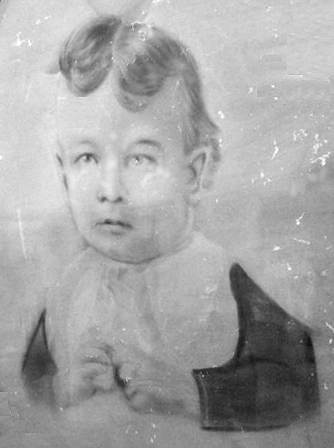
44 Willard Boyd - Age 2
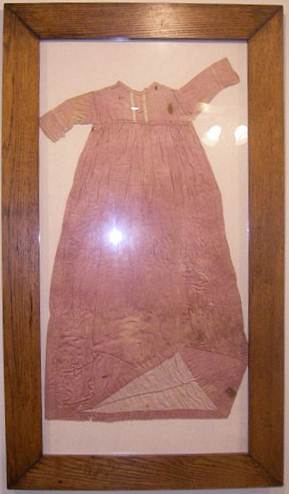
45 Willard Boyd Baby Garment
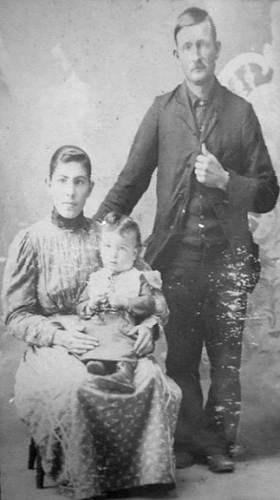
46 John and Dell Wickham Boyd with son Willard
We have been having really good turnouts of visitors every day we've been open
recently. One group which visited us last week was the Tuscumbia 7th and 8th grade summer
school classes (photo 47).
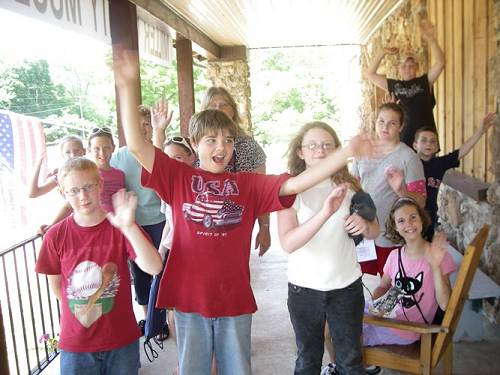
47 Tuscumbia Summer School Students
Lewis Wall of Iberia donated an old toy double barrel shotgun given him the Christmas
of 1936 (photo 48).
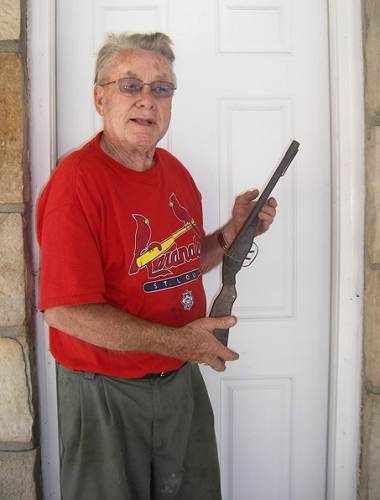
48 Lewis Wall and Old Toy Cork Shotgun
The miniature gun shoots corks out of the barrels. Lewis said that it also could
shoot rocks out the barrels too, something the manufacturer probably never intended, but
probably helped Lewis knock down a rat or two a little better than a cork.
That's all for this week.
| 


